Hawaiians at risk: Healing efforts return to roots

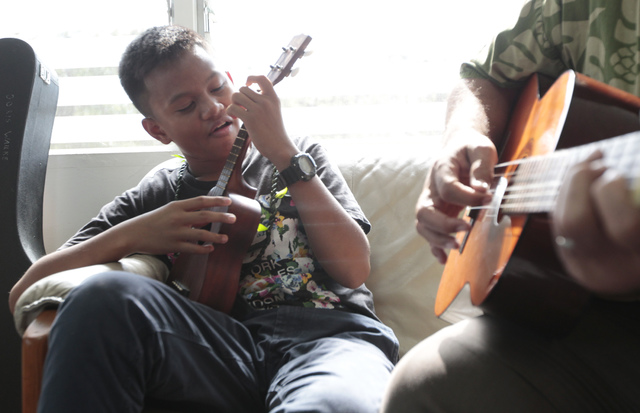
KRYSTLE MARCELLUS / KMARCELLUS@STARADVERTISER.COM
Above, Noah Bermudez and Wayde Hoapili Lee kick back with music during some downtime. Wahi Kana‘aho’s curriculum includes a range of activities that immerse participants in Hawaiian culture — computers and cellphones are nowhere to be found.
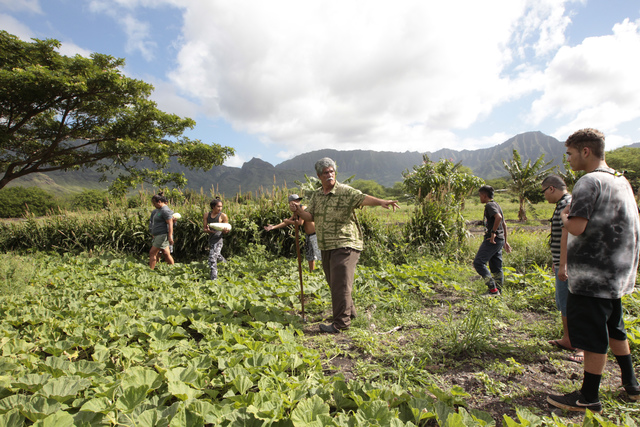
KRYSTLE MARCELLUS / KMARCELLUS@STARADVERTISER.COM
Above, Wayde Hoapili Lee guides a group of participants on their first day in his Wahi Kana‘aho program in Waianae Valley. The residential program is based on the Hawaiian cultural practice of hooponopono, which involves self-reflection to promote healing and stronger relationships. “Our ancestors have been doing this for centuries,” Lee says.

KRYSTLE MARCELLUS / KMARCELLUS@STARADVERTISER.COM
Lee leads the teenagers in prayer before an indoor session.

KRYSTLE MARCELLUS / KMARCELLUS@STARADVERTISER.COM
Wahi Kana‘aho counselor Momi Cruz-Losano, at right, listens to a guest speaker with Wahi Kana‘aho participant Landon Septimo.
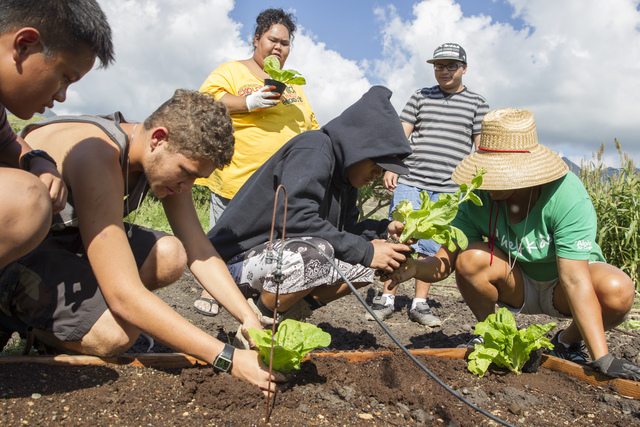
KRYSTLE MARCELLUS / KMARCELLUS@STARADVERTISER.COM
Wahi Kana‘aho participants Noah Bermudez, left, Jalen Gill, Landon Septimo and Kam Farm, standing, plant lettuce that they grew from seed with the help of counselor Jolyn Ballenti, in hat, and Mokihana Hanawahine, standing in back. The program begins with the teenagers preparing the soil and ends with them planting crops — symbolic of their own positive life transformation.

KRYSTLE MARCELLUS / KMARCELLUS@STARADVERTISER.COM
Reck Reichy takes a moment to reflect in his room on the first day of the Wahi Kana‘aho program. He and five other boys completed the 21-day curriculum in Waianae Valley that aims to help troubled youths restore balance and build stronger relationships.
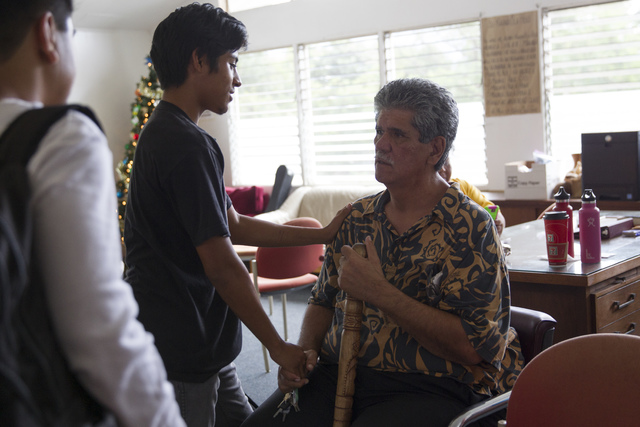
KRYSTLE MARCELLUS / KMARCELLUS@STARADVERTISER.COM
Above right, Wayde Hoapili Lee bids farewell to Brandon Chong after Brandon’s graduation from the 21-day program.
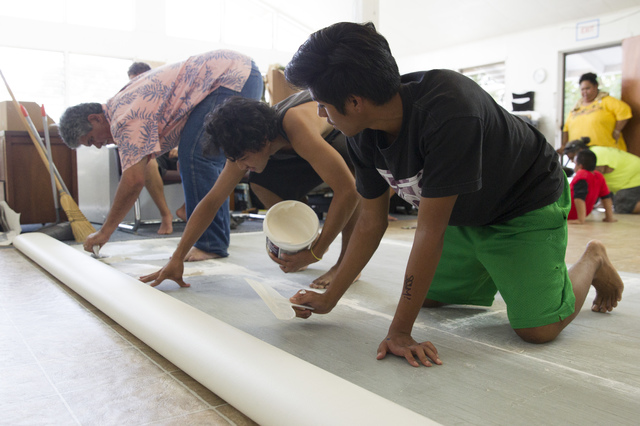
KRYSTLE MARCELLUS / KMARCELLUS@STARADVERTISER.COM
Above, Wayde Hoapili Lee helps Reck Reichy, center, and Brandon Chong install flooring at Community of Christ church in Waianae.
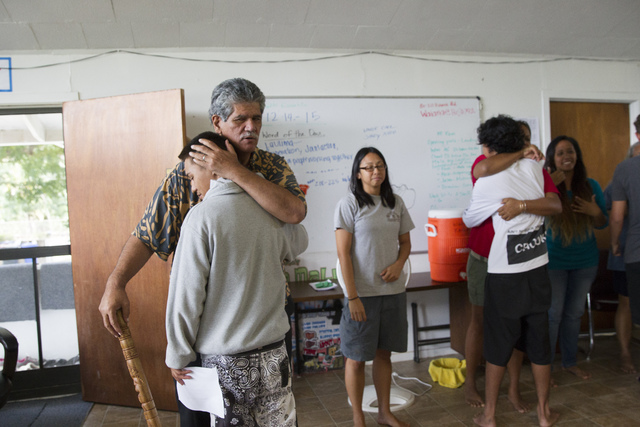
KRYSTLE MARCELLUS / KMARCELLUS@STARADVERTISER.COM
Wayde Hoapili Lee embraces Landon Septimo during Landon’s graduation from Wahi Kana‘aho.

KRYSTLE MARCELLUS / KMARCELLUS@STARADVERTISER.COM
The program’s newest class of graduates: Reck Reichy, left, Brandon Chong, Jalen Gill, Landon Septimo, Noah Bermudez and Kam Farm.
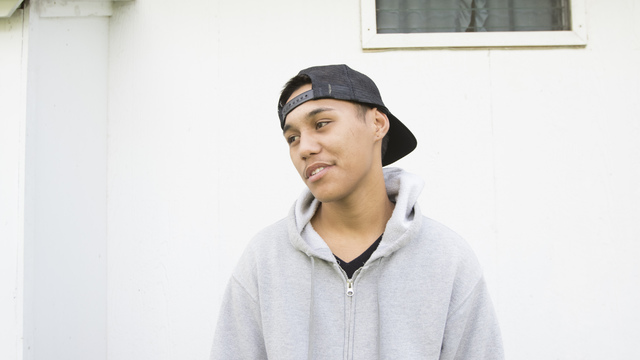
KRYSTLE MARCELLUS / KMARCELLUS@STARADVERTISER.COM
It really feels good, honestly. The weight just lifted from my shoulders.”
Landon Septimo
16-year-old from Waipio who graduated with five others from the program

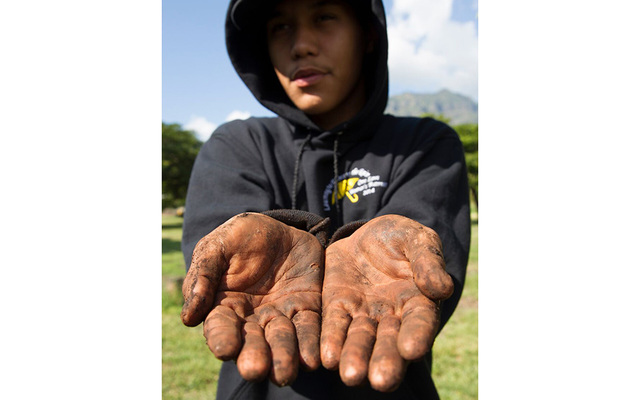
KRYSTLE MARCELLUS / KMARCELLUS@STARADVERTISER.COM
Landon Septimo shows off his hands dirtied by the day’s gardening.

KRYSTLE MARCELLUS / KMARCELLUS@STARADVERTISER.COM
They walked away with a new body of culturally grounded knowledge.”
Earl Kawa‘a
The cultural practitioner, below, created a program to help repair and strengthen family ties

KRYSTLE MARCELLUS / KMARCELLUS@STARADVERTISER.COM
Above right, Wayde Hoapili Lee helps Reck Reichy, center, and Brandon Chong install flooring at Community of Christ church in Waianae.
















The healing sessions are so intense and emotionally draining that the man who oversees them usually schedules just one a day.
Two sessions leave him mentally exhausted.
Under the firm but gentle guidance of Wayde Hoapili Lee, a Native Hawaiian cultural practitioner, the youths meet privately with their parents, guardians or others they are close to, confessing past wrongs, seeking forgiveness and expressing unconditional love.
The baring of souls happens around a long table that is the focal point of a facility tucked into the back of Waianae Valley. The rural setting serves as a tranquil backdrop for the sessions, where tears, Kleenex and hugs are plentiful.
Lee runs an innovative 21-day residential program for troubled youths, who mostly have had run-ins with the law over truancy, running away, behavior issues or minor drug offenses.
The curriculum revolves around the Hawaiian cultural practice called hooponopono, an intensely self-reflective process that stresses healing and strengthening relationships to restore balance in one’s life.
Don't miss out on what's happening!
Stay in touch with breaking news, as it happens, conveniently in your email inbox. It's FREE!
“This is a very unorthodox program, but it’s not new,” Lee said. “Our ancestors have been doing this for centuries.”
Lee’s program, known as Wahi Kana‘aho, is one of a small but growing number of Hawaiian culture-based initiatives aimed at helping Hawaiian youths who are overrepresented in the state’s foster care and juvenile justice systems. Some also involve parents.
For at least the past decade, the number of Hawaiians in both systems has been disproportionate to their numbers in the overall youth population. Few inroads have been made in rectifying the overrepresentation.
Cultural connection
Hoping to change that, the state and nonprofit groups have partnered in recent years to initiate programs like Lee’s, with the goal of reconnecting the youths and families to their culture.
Though the programs typically serve more than Hawaiians, they use Hawaiian cultural practices and values to try to build self-esteem, a sense of place and stronger family bonds.
The initiatives are designed to offset what their founders believe are the ill effects from the marginalization and degradation of the Hawaiian culture dating back generations. They liken the cultural disconnect to canoe voyagers floating aimlessly at sea, with no anchor to ground them or navigator to steer them.
“Historical trauma is very relevant to this population,” said Meripa Godinet, University of Hawaii associate professor at the Myron B. Thompson School of Social Work. “If you are taught not to appreciate who you are, that becomes part of your life.”
By reconnecting the youths and families to the traditions of their ancestors, the hope is that such a rekindling will restore a sense of pride and confidence in the participants, providing them with a more positive foundation for making everyday decisions.
The approach, though relatively new and mostly untested, is gaining acceptance.
“So many of our kids really don’t have a sense of self-worth and purpose and a sense of connection,” said Judge R. Mark Browning, who heads Family Court on Oahu and daily sees the trauma surrounding foster care and juvenile justice cases. “What these kind of programs do is help develop that sense of self-worth.”
One problem, though, is sustainability.
Although the initiatives have shown promising results anecdotally, they have not been around long enough to develop the kind of track record and outcome data that foundations, government agencies and other funding organizations seek, according to people who run and evaluate such initiatives.
The nonprofits need funds to sustain the services, yet funders want to know their money is going to programs with proven, evidence-based successes.
“It’s a chicken-and-egg issue,” said Karen Umemoto, a UH professor with the College of Social Sciences. Umemoto is helping Lee develop evaluation tools for Wahi Kana‘aho.
In the foster care and juvenile justice arenas, which sometimes include the same youths, the questions of effectiveness center on whether the programs make a difference in the long run.
Will families torn apart by abuse or neglect sufficiently heal so the children can exit the foster system and not return?
Will juveniles arrested for truancy, drug or other status and misdemeanor violations be able to change enough so they don’t become repeat offenders or graduate to harder offenses, eventually ending up in criminal court as adults?
Measuring success
One program showing positive results is Ke Kama Pono, a residential safe house for teen offenders that incorporates Hawaiian practices into its activities. Since the Partners in Development Foundation began operating the Kalaeloa facility in 2009, the recidivism rate — the teens were tracked for three years after leaving the program — has been 37 percent, according to Alison Masutani of the foundation.
In contrast, the Pew Charitable Trusts found a recidivism rate of 75 percent when it examined three-year outcomes of juveniles released from the Hawaii Youth Correctional Facility between 2005 and 2007.
The issue of how to measure effectiveness prompted operators of a Big Island program called Aha Koa to take a break last year.
The program used Hawaiian cultural practices, like traditional navigation techniques, as teaching tools to help fathers and sons build stronger relationships.
Four Aha Koa sessions were held in 2014, and “the feedback was really overwhelming,” said Kalani Motta, a Child Welfare Services worker and organizer of the program.
| Rob Perez reported this project with the support of the Fund for Journalism on Child Well-Being and the National Health Journalism Fellowship. Both are programs of the Center for Health Journalism at the University of Southern California Annenberg School of Journalism.
This project also was done in collaboration with Oiwi TV, the Native Hawaiian-owned and operated media outlet that tells stories from a Hawaiian perspective. For more video, see http://oiwi.tv/culture/keiki-hawaii-foster-care/ Opens in a new tab |
But the program was placed on hiatus last year to develop a method for measuring outcomes, according to Motta, who said he expected Aha Koa to restart early this year.
Cultural practitioner Earl Kawa‘a also tapped the Hawaiian culture to assist families involved with the child welfare system.
Under a Department of Human Services program that ended last year, he taught families to make traditional implements — a board and stone — for pounding poi, including the appropriate protocols for gathering the materials. Like other program providers, Kawa‘a used his classes — called One Board, One Stone, in Every Home — as a way to address repairing and strengthening family ties.
“They walked away with a new body of culturally grounded knowledge,” Kawa‘a said of the families.
Cultural practitioner Greg Dela Cruz of Maui uses Hawaiian values such as kuleana (responsibility) and malama (caring for, protecting) to teach his Kamalama parenting classes.
The genesis for Lee’s Waianae program came after Umemoto, the UH professor, and three co-authors published a 2012 report showing a substantial overrepresentation of Hawaiians in the juvenile justice system.
The study showed Hawaiians were arrested for juvenile violations or status offenses at a greater rate than any other ethnic group and were nearly twice as likely to be arrested as whites.
But the report also had another key finding: The Hawaiian offenders expressed the greatest level of remorse, acknowledging that what they did was wrong. That remorse, however, mostly went untapped, according to Lee, former chairman of the Juvenile Justice State Advisory Council.
“The problem is there’s no place in the system to ask for forgiveness,” he said.
Striving to reverse the seemingly endless cycle of arrests, Lee and others involved with the system held dozens of meetings in Hawaiian communities around the state, asking what was needed to get at the root of the overrepresentation problem.
They got their answer: People wanted a program grounded in culture, aina, ohana and spirituality, which are all part of Wahi Kana‘aho, according to Lee, who ran a similar program on Molokai.
Alternative remedy
Lee’s program, which must be staffed around the clock while the youths are at the Waianae facility, received $441,000 from DHS’ Office of Youth Services to fund 17 months of operations. Each 21-day session has a minimum of four youths and can accept up to 10.
The DHS grant was part of an initiative to address racial and ethnic disparities in the juvenile justice system. The Office of Hawaiian Affairs also contributed $200,000.
Wahi Kana‘aho is part of what is called Ho‘opono Mamo, a new civil citation system that provides youths previously arrested for status offenses (truancy, running away, etc.) or first-time misdemeanors an alternative to the juvenile justice system.
During their three-week stay the Wahi Kana‘aho clients are immersed in things Hawaiian.
There are no video games, televisions, computers or cellphones. The teens awake at 5:45 a.m. daily to a schedule of chores, meal-making, music, spiritual reflection, outdoor activities and discussions about Hawaiian values and history.
They learn to prepare a small plot of land for the planting of kalo (taro) and other crops and discuss the importance of the land and ocean to the Hawaiian culture.
Lee uses the process of preparing and harvesting the land as a metaphor, telling the teenagers they need to bring to their lives the same discipline required to successfully cultivate the crops.
So far, roughly 30 youths have gone through Wahi Kana‘aho since it launched in May. All came through the juvenile justice system, and at least half also spent time in foster care, Lee said.
Landon Septimo, a reserved 16-year-old who favors ball caps and lives in Waipio with his family, was one of them. He told the Honolulu Star-Advertiser he got into trouble for misconduct that included truancy and running away. The teenager was one of six boys who graduated from Wahi Kana‘aho’s latest session, which ended last month.
Landon, who is Hawaiian and Filipino, said the program helped him realize he shouldn’t keep his emotions bottled up, which made him depressed and angry a lot. He also realized he needed to express himself more in a truthful manner.
“It really feels good, honestly,” Landon told the Star-Advertiser a few days before his graduation. “The weight just lifted from my shoulders.”
Pouring out emotions
The centerpiece of Wahi Kana‘aho is the hooponopono session, where participants are told that “everything said at the table stays at the table.” Some youths have more than one.
In preparing for hooponopono, Lee tells his wards they need to first heal themselves before they can mend relationships with others. Forgiveness is vital to the process. The teenagers are encouraged to be honest and to speak from the heart, even if the conversations venture into painful territory.
The exchanges typically end in emotional embraces, with few dry eyes around the table. No one walks away unmoved.
“This place is not a punitive place,” said Jolyn Ballenti, one of the counselors who helps prepare the youths for their hooponopono. “This is a place of healing.”
Once the teens leave the program, they become healers themselves, a skill that can help them maintain a positive path, according to Lee.
He acknowledged that his program might not connect with some youths. One girl ran away days before her graduation.
But the preliminary results of an ongoing evaluation by Katherine Tibbetts, director of evaluation at Queen Lili‘uokalani Trust, have been promising.
During interviews with 14 participants from the first four Wahi Kana‘aho sessions, Tibbetts asked the teenagers to name the greatest strengths of the program. Their responses included learning about themselves and rebuilding broken bonds with family.
One teen summed it up this way: “This program is changing kids’ futures!”
Rob Perez reported this project with the support of the Fund for Journalism on Child Well-Being and the National Health Journalism Fellowship. Both are programs of the Center for Health Journalism at the University of Southern California Annenberg School of Journalism.
This project also was done in collaboration with Oiwi TV, the Native Hawaiian-owned and operated media outlet that tells stories from a Hawaiian perspective. For more video, see http://oiwi.tv/culture/keiki-hawaii-foster-care/
15 responses to “Hawaiians at risk: Healing efforts return to roots”
Leave a Reply
You must be logged in to post a comment.





It took a private company to help our youth in Hawaii. Where is the government when you need them?
Here’s a quote from the article: “Hoping to change that, the state and nonprofit groups have partnered in recent years to initiate programs like Lee’s…” Last time I checked, the state is the government.
That makes me happy that I pay taxes.
Children did not ask to be born. It is our job as adults to provide the best we are able to together as a family.
Kudos to Ron Perez for a very fine piece.
“University of Hawaii associate professor at the Myron B. Thompson School of Social Work. “If you are taught not to appreciate who you are, that becomes part of your life.”
This is the kind of social sciences mumbo jumbo that is part of the problem to begin with, and appears to be the opposite of what it is going on in this program.
It is who you are that is the problem and through repentance and forgiveness you can become a better person. Without that regret for who you are/were, there is no chance for transformation. It is not all about the self-indulgence of who you are now, it is about the who you are you can become.
Sorry, Cricket_Amos, I don’t believe you know what you’re talking about. Your whole last paragraph reads like fundamentalist Christian repentance mumbo-jumbo. Kids LEARN from their families, society, and peers how to perceive themselves; and too often, those lessons last a lifetime. If they are bullied, pushed to the side, and repeatedly told they don’t matter, then they will believe it and they will act out accordingly. The notion that these kids are somehow all “born bad” and need to “repent” and become someone else is the kind of nonsense that is making the mainstream systems fail the kids over and over again. Kudos to the brave people who are using traditional Hawaiian values to call forth the valuable and positive people inside these kids, and teaching them to honor that self and rejoice in it!
Hawaii needs strong woman leaders. NOT people like Governor Ige, and Mark Takai, they are embarrassments to America and to Hawaii. Send them home to Fukushima. This kind of political takeover will kill and destroy us.
You mean like the state representative from the Big Island that vented her racial bias at state workers? No names needed as the racially bias activities were reported here in the SA.
I got the poi pounder……just need the board…
If you teach a Hawaiian child to be Hawaiian you have helped him identify who he is. But his native language and past cultural history only has currency here in Hawaii. This child can remain who he is and probably find comfort and purpose in groups that a pose things like the TMT. Or that child can additionally grow in the current world and be a competitive member in the market place. Education in the real world is the key to his true happiness. Obama’s mother would awaken him early in the morning and go over his homework with him before school. How many Hawaiian families are doing this? Often the parents live in their own world and the kids live in the real competitive world of today. My mother spoke Hawaiian at home and English while at school. Teach and preach that education is the answer to happiness. Treat education as important, make a game of it, include public speaking cessions, spelling bees, history marvels, hands on building something. Take a trip somewhere and get the kids involved. Get the whole family involved.
“During their three-week stay the Wahi Kana‘aho clients are immersed in things Hawaiian.
There are no video games, televisions, computers or cellphones. The teens awake at 5:45 a.m. daily to a schedule of chores, meal-making, music, spiritual reflection, outdoor activities and discussions about Hawaiian values and history.
They learn to prepare a small plot of land for the planting of kalo (taro) and other crops and discuss the importance of the land and ocean to the Hawaiian culture.”
This is the key. All keikis in Hawaii nei need to go thru this. Many times.
[…] By working with the forgiveness process we grow in respect towards ourselves and others with less judgment. Here is an example. […]
[…] from Rob Perez’s “Hawaiians at Risk: Healing Efforts Return to Roots” Part 2 (Star-Advertiser, 11 Jan. […]
[…] http://www.staradvertiser.com/hawaii-news/hawaiians-at-risk-healing-efforts-return-to-roots/ […]